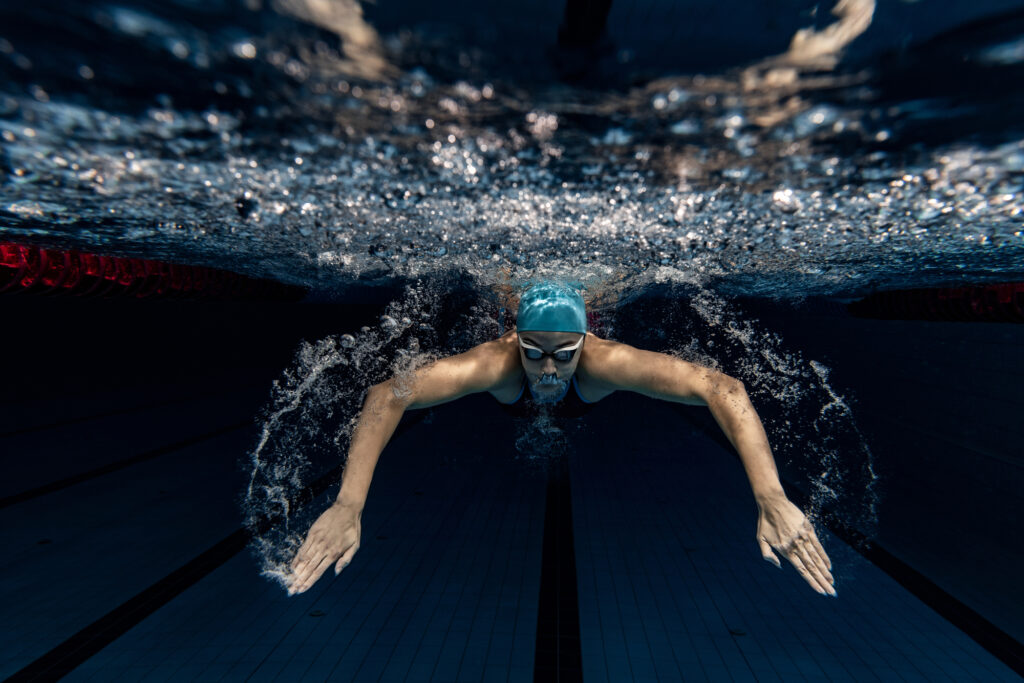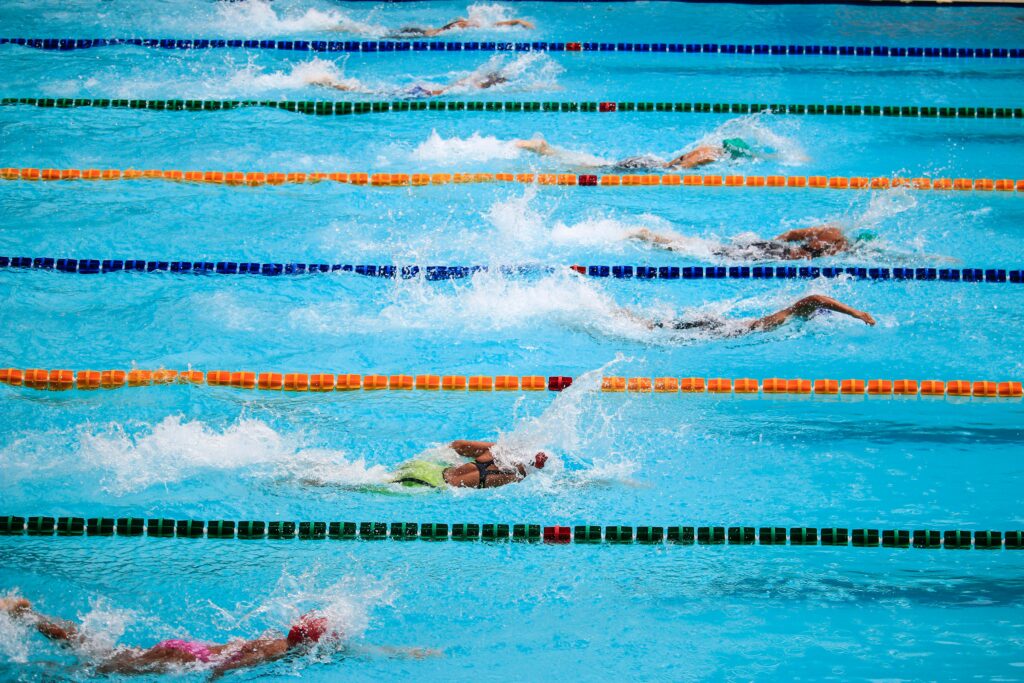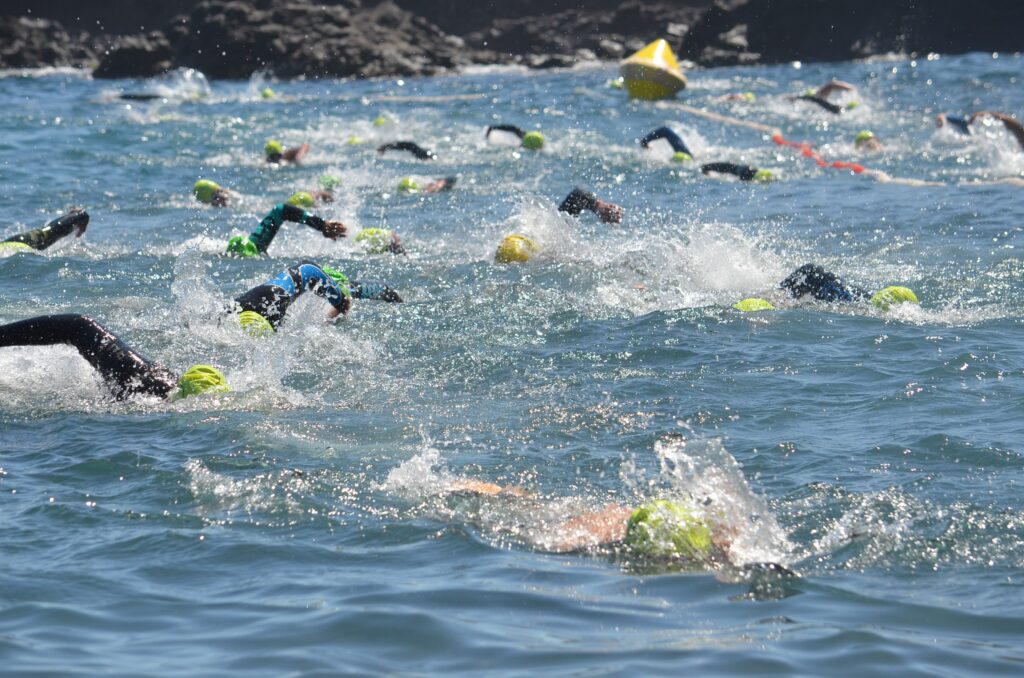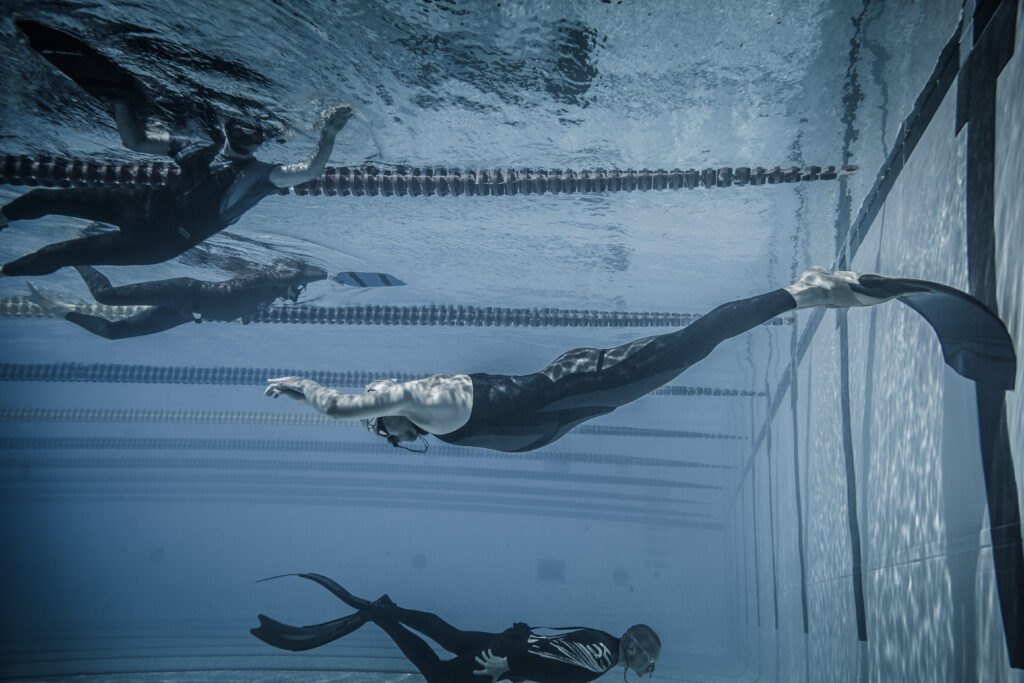Hypoxic swim training involves swimming with reduced oxygen intake by limiting breathing patterns during training sets. This technique has gained popularity amongst competitive swimmers seeking to enhance their performance and endurance capabilities. Hypoxic training can improve lung capacity, increase oxygen efficiency, and help swimmers develop better breath control whilst potentially enhancing their stroke technique.
The practice requires swimmers to take fewer breaths per length, which challenges the body to adapt to lower oxygen levels during exercise. Research shows that hypoxic training can help swimmers fix stroke issues that occur when breathing and may contribute to improved underwater performance. However, the technique must be approached with proper guidance and safety measures.
Understanding how to implement hypoxic training safely and effectively is crucial for swimmers looking to gain a competitive advantage. The following examination explores the physiological benefits, practical applications, and potential limitations of this training method to help swimmers make informed decisions about incorporating it into their training programmes.
Key Takeaways
- Hypoxic training improves lung capacity and oxygen efficiency by challenging swimmers to perform with reduced breathing frequency
- The technique can enhance stroke mechanics and underwater performance when implemented with proper coaching supervision
- Safety considerations and gradual progression are essential to avoid risks and maximise the benefits of hypoxic training methods
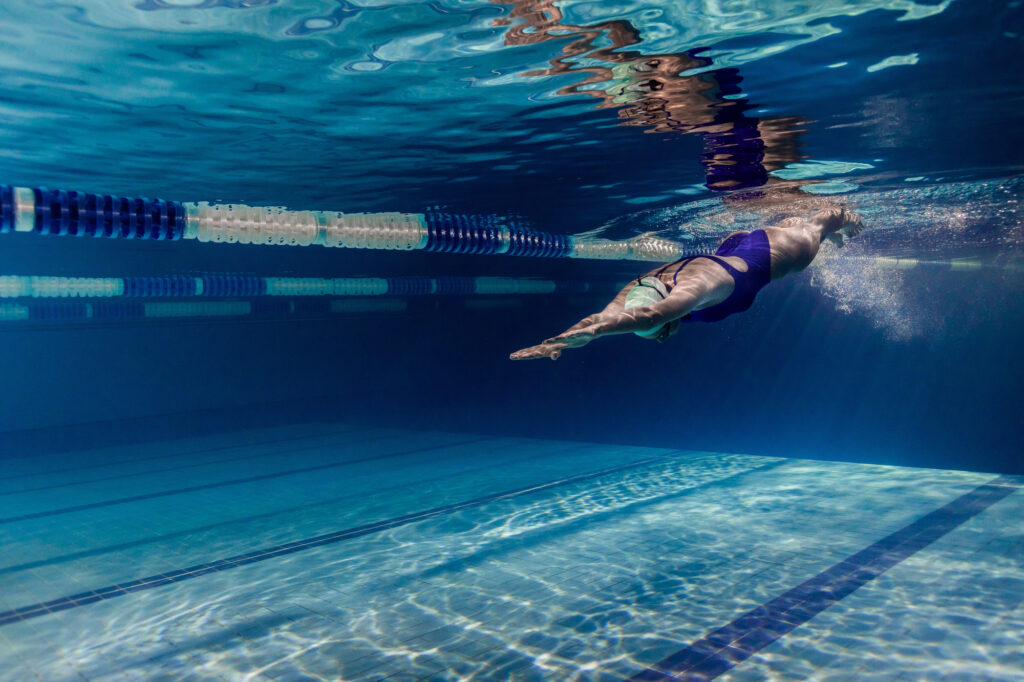
Understanding Hypoxic Swim Training
Hypoxic swim training involves swimming with reduced oxygen intake by limiting breathing patterns. This technique builds breath control skills and helps swimmers adapt to the discomfort of oxygen restriction during intense racing conditions.
Definition of Hypoxic Training
Hypoxic training refers to adapting to a reduced level of oxygen. In swimming, this means taking fewer breaths per length or stroke cycle than normal.
The term literally means training with little oxygen. Swimmers achieve this by breathing every 3, 5, 7, or 9 strokes instead of every 2 strokes.
The core concept challenges your body to adapt to lower levels of oxygen. This creates physiological stress that forces adaptation over time.
Common hypoxic sets include:
- Breath control sets: 200s breathing every 3/5/7/9 by 50
- Restricted breathing: Descending breaths per 25 (3-2-1-0 pattern)
- Underwater swimming: Short distances off starts and turns
The training simulates race conditions when swimmers must maintain breathing patterns under stress. It particularly helps during sprint finishes when oxygen demand exceeds supply.
Common Misconceptions and Safety Considerations
Many swimmers believe hypoxic training improves oxygen delivery to muscles. However, the urge to breathe is primarily driven by the impulse to purge CO2 from the lungs, not a deficit of O2.
Key Safety Rules:
- Never attempt long underwater distances (50+ metres)
- Always train with proper supervision
- Avoid competitive distance breath holding
- Stop immediately if experiencing dizziness or discomfort
There have been preventable tragedies in recent years due to shallow water blackout. Swimmers must prioritise safety over performance gains.
The training does not significantly improve aerobic capacity. Instead, it builds tolerance to CO2 buildup and breath control skills.
Swimmers often reduce speed to manage restricted breathing. This defeats the purpose of race-specific training if not monitored properly.
Differences Between Breath Holding and Hypoxic Sets
Breath holding involves swimming underwater for extended distances without breathing. Hypoxic sets involve surface swimming with reduced breathing frequency.
Breath Holding Characteristics:
- Complete oxygen restriction
- High risk of blackout
- Limited training value
- Dangerous without supervision
Hypoxic Set Characteristics:
- Controlled oxygen reduction
- Surface swimming maintained
- Safer execution
- Builds race-specific skills
Underwater swimming for distance is the danger zone with very little physiological benefit. The competitive nature encourages athletes to push dangerous limits.
Proper hypoxic training focuses on breathing patterns like 3-5-7-9 strokes. This maintains safety whilst building breath control skills.
The distinction matters because hypoxic sets can be stopped immediately if distress occurs. Underwater swimming creates risk of blackout before the swimmer can react.
Coaches should emphasise the 15-metre underwater limit off starts and turns rather than distance breath holding.
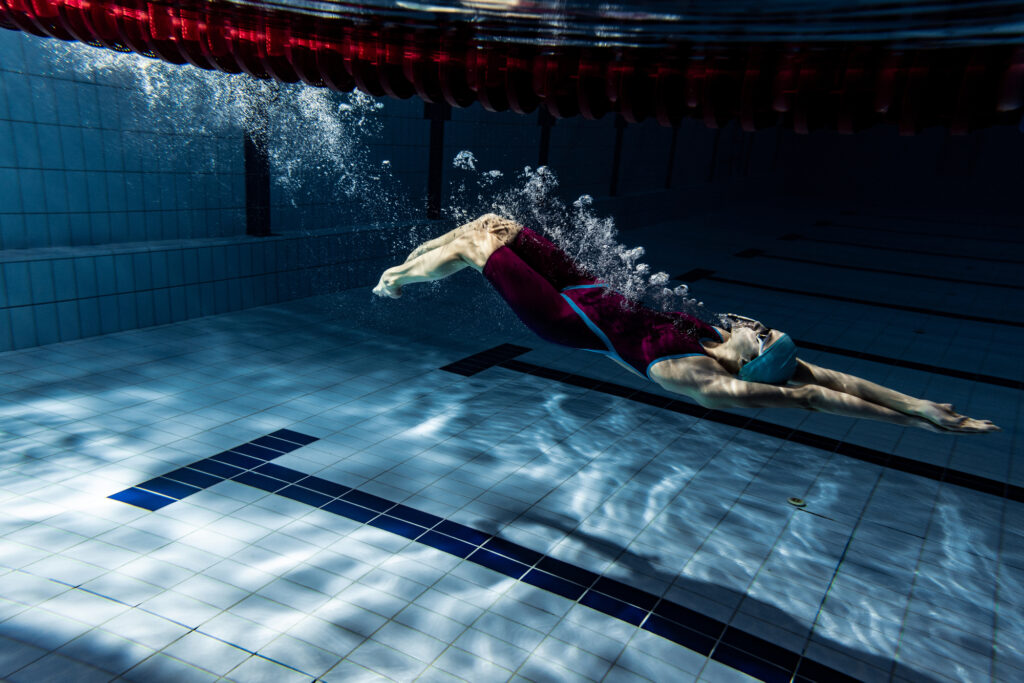
Physiological Benefits of Hypoxic Swim Training
Hypoxic training triggers specific physiological adaptations that enhance oxygen delivery and utilisation throughout the body. These adaptations primarily affect the cardiovascular system, blood composition, and respiratory muscles.
Improved Aerobic Capacity and Cardiovascular Adaptation
Hypoxic training stimulates significant cardiovascular improvements in swimmers. The heart adapts to reduced oxygen availability by increasing its efficiency and pumping capacity.
During hypoxic conditions, the cardiovascular system undergoes several key adaptations:
- Increased stroke volume: The heart pumps more blood with each beat
- Enhanced cardiac output: Overall blood flow improves during exercise
- Improved oxygen delivery: Blood vessels become more efficient at transporting oxygen
Research shows that swimmers who complete 6 weeks of hypoxic training experience increased maximal oxygen consumption. This improvement in aerobic capacity translates directly to better endurance performance in the pool.
The heart rate response also becomes more efficient. Swimmers develop the ability to maintain higher intensities at lower heart rates. This adaptation allows for sustained performance over longer distances.
Blood flow to working muscles increases through enhanced capillarisation. More capillaries develop around muscle fibres, improving oxygen and nutrient delivery during intense training sessions.
Increased Haemoglobin and Oxygen Utilisation
Hypoxic training stimulates the production of erythropoietin, a hormone that increases red blood cell production. This leads to higher haemoglobin concentrations in the blood.
Higher haemoglobin levels provide several performance benefits:
| Adaptation | Benefit |
|---|---|
| Increased red blood cell count | More oxygen-carrying capacity |
| Enhanced haemoglobin concentration | Improved oxygen transport |
| Better oxygen utilisation | More efficient energy production |
The body becomes more efficient at extracting oxygen from the blood. Muscles develop enhanced oxygen utilisation capabilities through improved mitochondrial function.
Studies demonstrate that hypoxic training enhances the oxygen transporting and utilising capacity of the blood. This adaptation occurs through increased erythropoietin synthesis and elevated red blood cell volume.
Swimmers experience improved exercise economy as their bodies learn to work more efficiently with available oxygen. This translates to better performance at race pace intensities.
Enhanced Respiratory Muscle Strength
Hypoxic training strengthens the diaphragm and other respiratory muscles. These muscles must work harder when oxygen availability is limited, leading to improved strength and endurance.
The respiratory system adapts in several ways:
- Stronger diaphragm: Primary breathing muscle becomes more powerful
- Improved lung efficiency: Better oxygen extraction from each breath
- Enhanced breathing control: More efficient breathing patterns during swimming
Swimmers develop better breathing technique through hypoxic training. They learn to maximise oxygen intake with each breath whilst maintaining proper stroke mechanics.
The increased respiratory muscle strength allows swimmers to maintain proper breathing patterns even during high-intensity efforts. This prevents the deterioration in technique that often occurs when swimmers become breathless.
Research indicates that hypoxic training can help swimmers address stroke issues that occur when they breathe. Stronger respiratory muscles support more controlled and efficient breathing during competition.
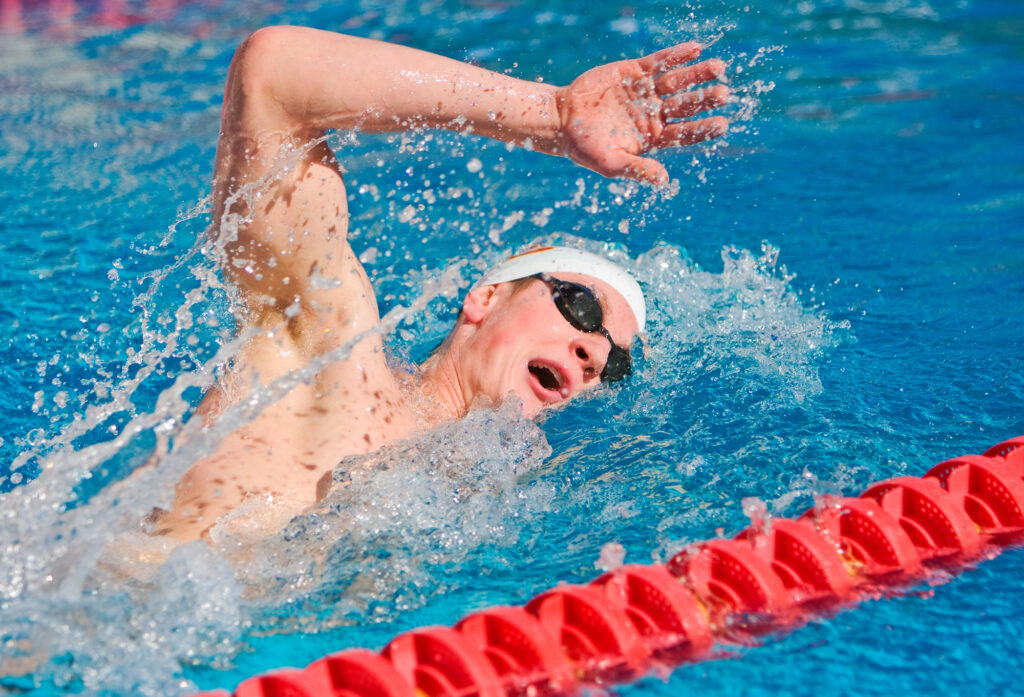
Breathing Pattern and Technique Enhancements
Hypoxic training helps swimmers develop controlled breathing patterns and enhances stroke mechanics through restricted oxygen exposure. This training method improves breathing frequency management and creates more efficient swimming techniques.
Breath Control and Breathing Frequency
Swimmers develop enhanced breath control through systematic reduction of breathing frequency during training sets. This practice forces the body to maximise oxygen utilisation between breaths.
Training protocols typically progress from comfortable breathing patterns to more restrictive ones. Swimmers might begin with breathing every third stroke and gradually extend to every fifth or seventh stroke.
The urge to breathe primarily stems from carbon dioxide buildup rather than oxygen depletion. Understanding this physiological response helps swimmers tolerate longer periods between breaths.
Common progression patterns include:
- Week 1-2: Breathing every 3rd stroke
- Week 3-4: Breathing every 5th stroke
- Week 5-6: Breathing every 7th stroke
- Advanced: Mixed patterns within single lengths
Regular practice with restricted breathing frequency trains the respiratory muscles to work more efficiently. This adaptation proves particularly valuable during race conditions when breathing rhythm may be disrupted.
Optimising Breathing Patterns in Competitive Swimming
Breath control sets help swimmers become more aware of stroke inefficiencies that occur during breathing cycles. Many swimmers unconsciously alter their stroke mechanics when turning to breathe.
Competitive swimmers benefit from bilateral breathing patterns developed through hypoxic training. This technique allows breathing on both sides, providing tactical advantages during races.
Key breathing pattern improvements include:
- Reduced head movement during breathing
- Maintained body position throughout breathing cycles
- Consistent stroke timing regardless of breathing side
- Enhanced ability to sight without disrupting rhythm
Training with restricted breathing patterns prepares swimmers for race-specific scenarios. The final 25-50 metres of competitive events often require reduced breathing frequency to maintain maximum speed.
Swimmers learn to time their breathing strategically around turns and sprint finishes. This skill becomes crucial during tight race situations where every stroke counts.
Impact on Stroke Efficiency
Hypoxic training promotes greater propulsive continuity by reducing interruptions in stroke mechanics. Swimmers develop smoother, more consistent strokes when breathing becomes less frequent.
Technical improvements often emerge when swimmers focus on maintaining stroke quality whilst managing reduced oxygen availability. This dual challenge enhances overall swimming efficiency.
Stroke efficiency gains include:
- Improved catch and pull phases
- Better body rotation timing
- Enhanced underwater streamlining
- Reduced energy waste during breathing
The training method exposes technical flaws that become apparent under oxygen stress. Swimmers must maintain proper technique whilst managing physiological discomfort.
Stroke rate consistency improves as swimmers learn to maintain rhythm regardless of breathing pattern. This skill translates directly to competitive performance where stroke rate management determines race outcomes.
Long-term practice with varied breathing patterns creates more adaptable swimmers. They can adjust their technique based on race conditions, lane position, and tactical requirements without losing efficiency.
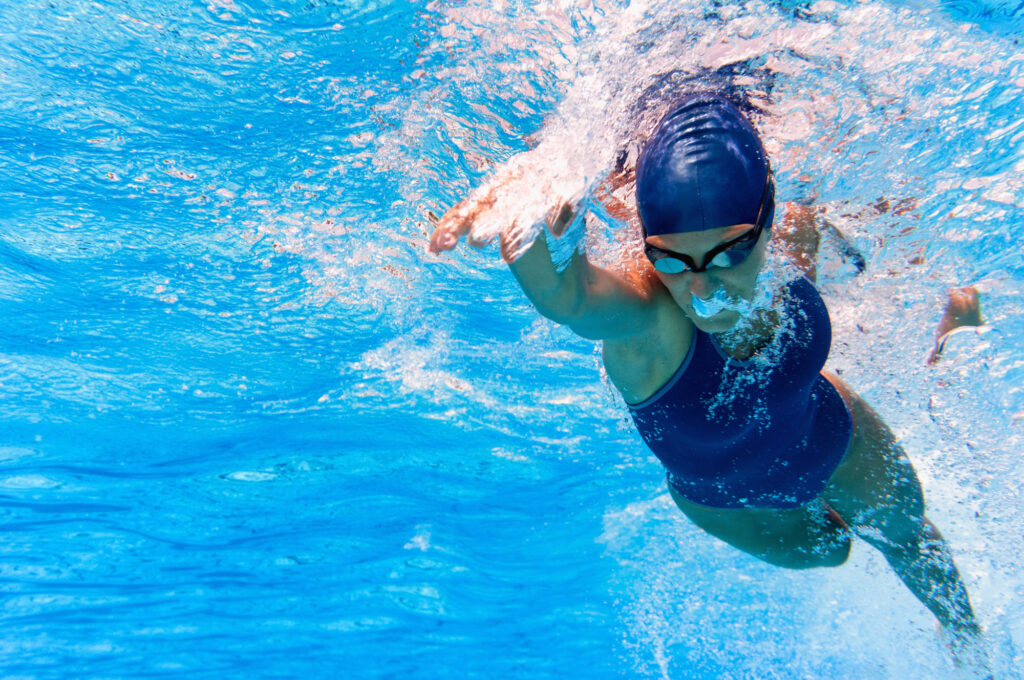
Performance Improvements in Competitive Swimming
Hypoxic training delivers measurable performance gains for competitive swimmers through race-specific preparation and enhanced mental resilience. Intermittent hypoxic training improves anaerobic performance by 2.1% in 100m events and 1.8% in 200m events compared to standard training methods.
Hypoxic Sets for Race Simulation
Competitive swimmers use hypoxic sets to replicate race conditions where breathing becomes restricted during intense efforts. These sets involve swimming multiple strokes without breathing, typically in patterns of 3, 5, or 7 strokes per breath.
Common Hypoxic Set Patterns:
- 4-8 x 25m freestyle with breathing once per length
- Pyramid breathing: 3-5-7-5-3 strokes per breath across 100m
- Broken swims: 200m split into 4 x 50m with restricted breathing
Research shows that hypoxic training can improve swimming technique by promoting greater propulsive continuity. Swimmers maintain stroke rhythm without the disruption of frequent breathing.
The final 25m of races often requires reduced breathing frequency. Hypoxic sets prepare swimmers for this oxygen debt whilst maintaining stroke efficiency and speed.
Mental Toughness and Focus Under Pressure
Hypoxic training builds psychological resilience essential for competitive performance. Swimmers learn to manage discomfort and maintain focus when oxygen becomes limited during races.
The training creates controlled stress that mimics race conditions. Athletes develop confidence in their ability to perform under physiological pressure.
Key Mental Benefits:
- Panic control: Swimmers learn to stay calm when air-hungry
- Stroke discipline: Maintaining technique despite discomfort
- Race confidence: Reduced anxiety about breathing restrictions
Hypoxic training builds mental toughness by teaching swimmers to tolerate higher levels of carbon dioxide. This adaptation helps athletes push through the final stages of races when breathing becomes laboured.
Training Underwater Phases Effectively
Underwater dolphin kick phases benefit significantly from hypoxic training adaptations. Swimmers can extend their underwater distance whilst maintaining kick quality and speed.
Modern competitive swimming allows 15m underwater off each wall. Hypoxic training helps swimmers maximise this advantage without surfacing prematurely due to air hunger.
Underwater Training Progressions:
- Kick sets: 8 x 25m with 20m underwater
- Breath holds: Static apnea training for lung capacity
- Speed work: 50m swims with extended underwater phases
The underwater dolphin kick generates more speed than surface swimming in the first 15m. Hypoxic training enhances oxygen efficiency during these crucial underwater phases.
Swimmers develop better body awareness and kick rhythm when oxygen becomes limited. This translates to more consistent underwater performance during competition.
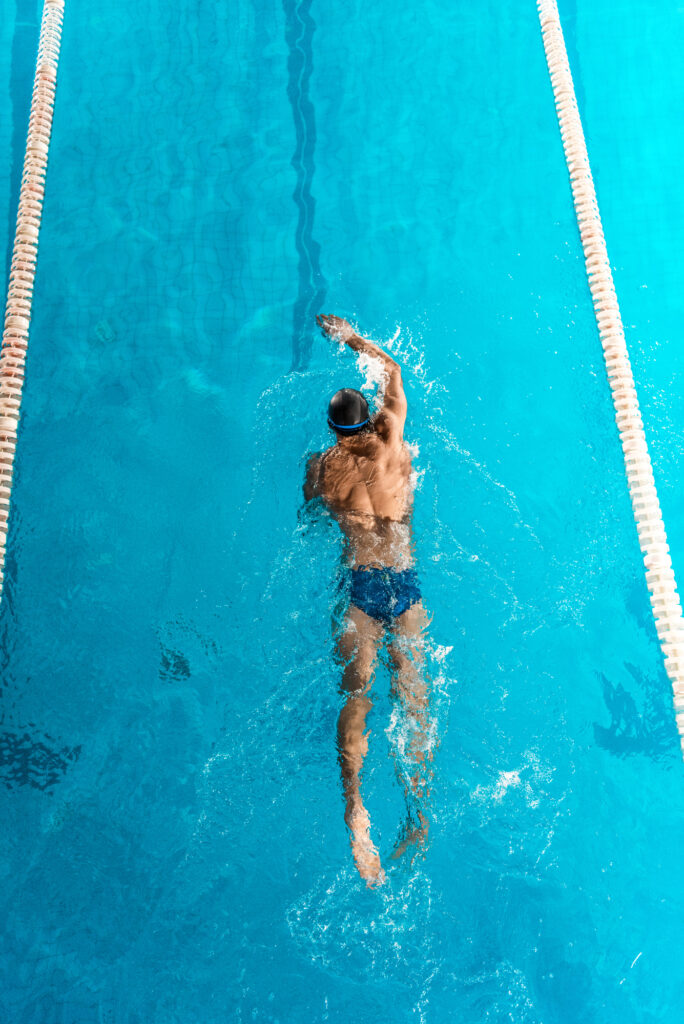
Practical Applications: Drills and Training Methods
Effective hypoxic training requires structured drills that gradually build breath control whilst maintaining proper technique. These methods range from simple breathing pattern modifications to advanced underwater work and interval training protocols.
Progressive Breathing Drills and Pyramid Patterns
Progressive breathing drills start with comfortable patterns and gradually increase the challenge. Swimmers begin with bilateral breathing (every 3 strokes) before progressing to every 5, 7, or 9 strokes.
Basic progression sequence:
- Week 1: 3-5-3-5 breathing pattern
- Week 2: 3-5-7-5-3 breathing pattern
- Week 3: 5-7-9-7-5 breathing pattern
Pyramid patterns work particularly well for building tolerance. A typical pyramid might involve breathing every 3 strokes for 25 metres, then every 5 strokes for 25 metres, followed by every 7 strokes for 25 metres.
The swimmer then reverses the pattern back down the pyramid. This approach allows for gradual adaptation whilst preventing excessive oxygen debt.
Advanced freestyle swimmers can incorporate these drills into their regular training routine. The key is maintaining stroke technique even when holding your breath for extended periods.
Integrating Hypoxic Work into Swim Workouts
Hypoxic training shouldn’t dominate entire sessions but rather complement regular training. Most coaches recommend limiting hypoxic work to 10-20% of total training volume.
Typical integration methods:
- Warm-up phase: Light hypoxic breathing during easy swimming
- Main set: One or two hypoxic intervals within regular sets
- Cool-down: Gentle breath control work
The timing within workouts matters significantly. Fresh swimmers handle hypoxic challenges better early in sessions rather than when fatigued.
Incorporating hypoxic sets into regular training helps address stroke issues that occur during breathing. Swimmers often develop timing problems or lose body position when turning to breathe.
Recovery between hypoxic efforts should be adequate. Swimmers need sufficient oxygen replenishment before attempting subsequent hypoxic sets.
Underwater Dolphin Kicks and Kicking Sets
Underwater dolphin kicks represent one of the most effective hypoxic training methods. These kicks naturally limit breathing whilst building core strength and leg power.
Standard underwater kicking progressions begin with short distances. Swimmers might start with 5-metre underwater kicks off each wall, gradually increasing to 10-15 metres as tolerance improves.
Progressive kicking sequence:
- Beginner: 5m underwater off each wall
- Intermediate: 10m underwater off each wall
- Advanced: 15m underwater off each wall
Vertical kicking sets also provide excellent hypoxic training. Swimmers perform dolphin kicks in deep water whilst maintaining vertical position. These sets typically last 15-30 seconds with adequate recovery.
The underwater dolphin kick develops breath control naturally. Swimmers must time their surfacing precisely to avoid taking emergency breaths.
Safety remains paramount during underwater work. Swimmers should never push beyond comfortable limits or attempt underwater swimming without proper supervision.
Descending Breath Sets and Interval Training
Descending breath sets combine speed work with progressive hypoxic challenge. Swimmers complete multiple repetitions whilst gradually reducing breathing frequency.
A typical descending set might involve 4 x 50m freestyle with breathing patterns of 3-5-7-9 strokes respectively. Each repetition should maintain or increase pace despite reduced oxygen intake.
Sample descending breath set:
- 50m breathing every 3 strokes (target time: 35 seconds)
- 50m breathing every 5 strokes (target time: 35 seconds)
- 50m breathing every 7 strokes (target time: 36 seconds)
- 50m breathing every 9 strokes (target time: 37 seconds)
Interval training with breathing patterns requires careful pace management. Swimmers must balance speed with sustainable breath control throughout the set.
Rest intervals between repetitions should allow partial recovery but not complete oxygen replenishment. Typical rest periods range from 10-30 seconds depending on the set’s intensity and the swimmer’s fitness level.
Potential Risks and Limitations
While hypoxic swim training offers performance benefits, it carries significant safety risks that swimmers and coaches must understand. The dangers of hypoxic training and shallow-water blackout are real, requiring careful attention to proper protocols and individual limitations.
Dangers of Prolonged Breath Holding
Extended breath holding during swimming creates dangerous physiological conditions that can lead to unconsciousness. When swimmers hold their breath for too long, oxygen levels drop whilst carbon dioxide builds up in the bloodstream.
This combination of hypoxia and hypercapnia can cause a swimmer to lose consciousness underwater without warning. The brain’s oxygen demands cannot be met, leading to fainting beneath the surface.
Warning signs include:
- Dizziness or lightheadedness
- Tingling sensations
- Visual disturbances
- Confusion or disorientation
Swimmers often misjudge their limits, particularly when pushing through discomfort. The urge to breathe diminishes as carbon dioxide tolerance increases, masking the body’s actual oxygen needs.
Prolonged breath holding should never be practised without proper supervision. Pool depth and proximity to safety personnel become critical factors in preventing drowning incidents.
Risks of Hyperventilation and Shallow Water Blackout
Hyperventilation before breath holding creates a particularly dangerous scenario that can lead to shallow water blackout. This rapid breathing reduces carbon dioxide levels whilst barely increasing oxygen stores.
The reduced carbon dioxide delays the body’s natural breathing reflex. Swimmers feel they can hold their breath longer, but oxygen levels drop dangerously low before the urge to breathe returns.
Shallow water blackout occurs when swimmers lose consciousness due to insufficient oxygen reaching the brain. This can happen in water as shallow as one metre.
High-risk behaviours include:
- Taking multiple deep breaths before underwater swimming
- Competing to see who can swim furthest underwater
- Practising breath holding without supervision
- Ignoring safety protocols during training
The condition is particularly deceptive because swimmers often feel confident and capable moments before losing consciousness. Recovery can be rapid once the person reaches the surface, but drowning can occur within minutes if unnoticed.
Appropriate Usage for Different Skill Levels
Hypoxic training isn’t suitable for beginners and requires careful progression based on swimming ability and experience. Novice swimmers should focus on basic breathing techniques before attempting any breath control exercises.
Intermediate swimmers can begin with simple breathing pattern changes, such as breathing every fifth stroke instead of every third. These modifications should occur during regular training sets rather than dedicated breath holding exercises.
Advanced swimmers may incorporate more challenging hypoxic sets under proper supervision. However, even experienced athletes must follow strict safety protocols and never train alone.
Skill level guidelines:
- Beginners: Focus on rhythmic breathing patterns only
- Intermediate: Limited breathing pattern variations with supervision
- Advanced: Structured hypoxic sets with safety measures in place
USA Swimming guidelines recommend limiting hypoxic training to surface drills rather than underwater breath holding. Coaches should receive proper education about risks and safety procedures before implementing these training methods.
Age also plays a crucial role in determining appropriate usage. Young swimmers have less developed breathing control and may not recognise warning signs of oxygen deprivation.

